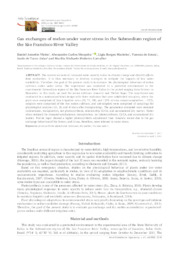Gas exchanges of melon under water stress in the Submedium region of the São Francisco River Valley.
Gas exchanges of melon under water stress in the Submedium region of the São Francisco River Valley.
Author(s): VIEIRA, D. A.; MESQUITA, A. C.; MARINHO, L. B.; SOUZA, V. de; AIDAR, S. de T.; CARVALHO, M. M. P.
Summary: The current scenario of increased water scarcity is due to climate change and directly affects food production. It is thus necessary to develop strategies to mitigate the impacts of low water availability. Therefore, the goal of the present study is to evaluate the physiological behaviour of melon cultivars under water stress. The experiment was conducted in a protected environment in the experimental Submedium region of the São Francisco River Valley in the period ranging from October to December. In this study, we used the melon cultivars 'Amarelo' and 'Piel de Sapo'. The experiment was conducted in a randomized block design with three replicates that were subdivided into plots, where the plots were comprised of four irrigation rates (50, 75, 100, and 125% of crop vapotranspiration ? CET), subplots were comprised of the two melon cultivars, and sub-subplots were comprised of samplings for physiological analyses (15, 30, and 45 days after transplanting). The parameters evaluated were stomatal conductance, transpiration, net photosynthesis, relationship CI/CA, and accumulated dry matter. Water stress reduced the stomatal conductance, transpiration, net photosynthesis, CI/CA, and accumulated dry matter. 'Piel de Sapo' showed a higher photosynthetic adjustment than 'Amarelo' melon due to the gas exchange behaviour of the former, and it was, therefore, more tolerant to water stress.
Publication year: 2019
Types of publication: Journal article
Unit: Embrapa Semi-arid Region
Observation
Some of Embrapa's publications are published as ePub files. To read them, use or download one of the following free software options to your computer or mobile device. Android: Google Play Books; IOS: iBooks; Windows and Linux: Calibre.
Access other publications
Access the Agricultural Research Database (BDPA) to consult Embrapa's full library collection and records.
Visit Embrapa Bookstore to purchase books and other publications sold by Embrapa.

